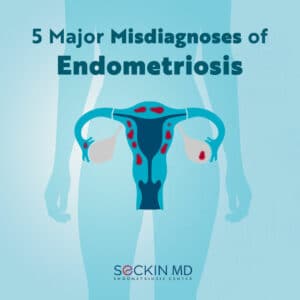5 Major Misdiagnoses of Endometriosis

A proper diagnosis of endometriosis is a complicated process and often requires the expertise of a specialist in the field. Unfortunately, many physicians still do not understand and fail to recognize the signs and symptoms of the disease. So, women continue to receive misdiagnoses that result in wrong and unnecessary treatments. Below are the 5 major misdiagnoses of endometriosis.
Irritable bowel syndrome (IBS)
IBS can lead to symptoms such as cramping, pain, gas, bloating, diarrhea, and/or constipation affecting the gastrointestinal (GI) tract.
More than 90% of women with endometriosis also show similar symptoms, which means that they receive a wrong diagnosis.
A proper pelvic examination and careful analysis of the patient’s medical history by a specialist are necessary to differentiate the two conditions.
It is possible to diagnose by looking inside the bowels using endoscopy. However, the only way to distinguish and confirm endometriosis is by laparoscopic deep excision surgery and a histological examination.
Leaky gut syndrome
A leaky gut is an indication that there’s an underlying condition causing increased permeability of the gastrointestinal tract.
Leaky gut can occur alongside other diseases such as autoimmune disorders, Crohn’s disease, IBS, obesity, and more. Patients with leaky gut may show symptoms such as diarrhea, fatigue, and bloating which are also present in endometriosis. This means that women with endometriosis may receive a misdiagnosis of leaky gut syndrome and have their endometriosis left untreated.
Small intestinal bacterial overgrowth (SIBO)
SIBO occurs when there is an excess bacterial buildup in the small intestine, often by bacteria not commonly found in this region. The slow movement of food in the small intestine as a result of changes in its structure, surgery, or due to certain conditions such as Crohn’s disease, celiac disease, or diabetes can cause this buildup.
SIBO can cause endo belly, which is an indication of endometriosis in the abdomen and is often misdiagnosed as IBS. Women with endo belly experience debilitating pain and a belly that feels rock hard.
Hemorrhagic cysts
Hemorrhagic cysts are a form of ovarian cysts that form when the corpus luteum in the ovary does not dissolve in the right timeline. This is 14 days after ovulation without fertilization or 14 weeks after pregnancy. The necrotic tissue in the cysts causes blood to stay within the cyst itself.
Hemorrhagic cysts often do not require treatment and go away on their own within a few weeks. However, if the “cyst” is present for more than two months, and if there are symptoms of painful periods or discomfort and gastrointestinal problems, then it is not a hemorrhagic cyst and is most likely endometrioma and should be treated.
Cancer
Some women with endometriosis can be misdiagnosed with cancer and receive unnecessary and wrong treatments, which can cause lots of distress.
A form of endometriosis called ovarian endometrioma may have symptoms that overlap with those of ovarian cancer. The only way to reach a definite diagnosis is by laparoscopic deep excision surgery and then histological analysis.
Endometriosis is an estrogen-dependent inflammatory disease in the pelvis. Therefore, 80 to 90% of patients with endometriosis experience gastrointestinal symptoms such as gas, bloating, painful bowel movement, constipation, and diarrhea often leading to these misdiagnoses.
Have you received any of these misdiagnoses of endometriosis? Please do not hesitate to share your story by leaving a comment on our post on Facebook or Instagram if you wish.
Get a Second Opinion
Our endometriosis specialists are dedicated to providing patients with expert care. Whether you have been diagnosed or are looking to find a doctor, they are ready to help.Our office is located on 872 Fifth Avenue New York, NY 10065.
You may call us at (646) 960-3080 or have your case reviewed by clicking here.